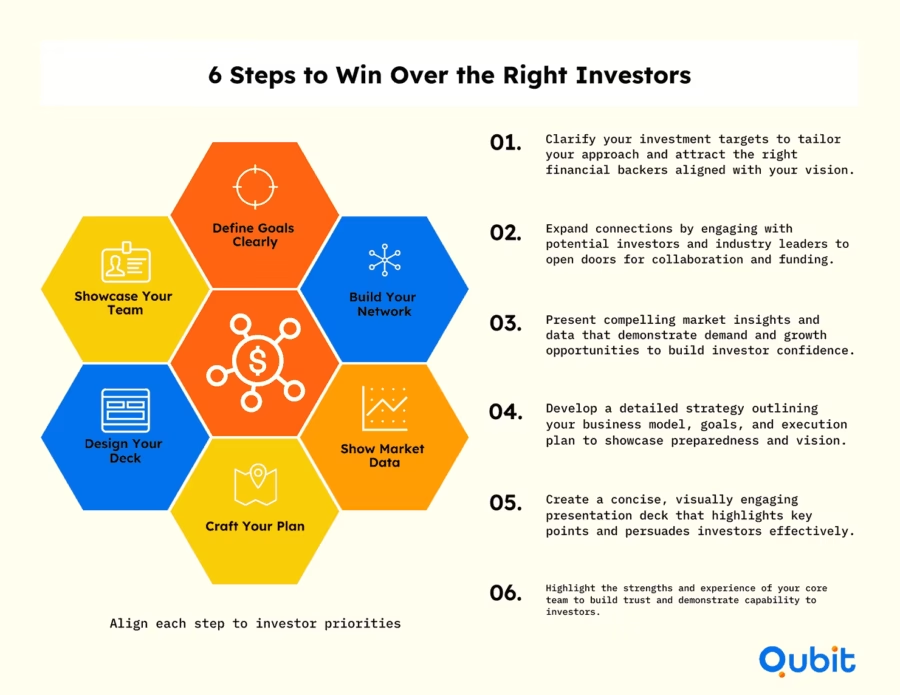Securing funding is often the defining challenge for entrepreneurs aiming to scale their businesses. Investors are not just looking for promising ideas—they seek compelling narratives, solid financial projections, and alignment with their own goals. Strengthen relationships with potential funding individuals by refining your investor outreach strategies.
This blog explores actionable strategies to help you master the art of persuasion and secure the capital you need. From crafting a pitch that resonates to building meaningful connections, every step matters.
How to Find and Win Over the Right Investors
Securing the right investors is a pivotal step for any startup aiming to scale effectively. To achieve this, entrepreneurs must align their goals with investor expectations, utilize strategic networking opportunities, and present compelling market data that validates their business potential. This section outlines actionable investor pitch strategies to help startups attract funding and build lasting partnerships.

1. Define Clear Entrepreneurial Goals
Investors are drawn to startups with a well-defined vision. Begin by identifying your short-term and long-term objectives, ensuring they align with the type of investor you’re targeting. For instance, angel investors often prioritize early-stage innovation, while venture capitalists focus on scalability and market size. Highlighting your goals in a concise and measurable way demonstrates your commitment and clarity.
2. Build a Strong Network
Networking is essential for connecting with investors who share your vision. Start by exploring established platforms like Angel networks to identify investors aligned with your industry. Additionally, attending events hosted by organizations such as the UKBAA and BVCA can open doors to valuable connections. These events provide opportunities to pitch your ideas directly to investors and gain insights into their priorities.
3. Showcase Market Potential with Robust Metrics
Investors often prioritize market size over current traction, with 72% of VCs emphasizing this factor during evaluations. To stand out, back your pitch with credible market data sourced from platforms like ONS data or the BL BIPC. Tools like SurveyMonkey and Typeform can help you gather customer insights, while the MRS guide offers access to specialized research agencies for more in-depth analysis. Presenting detailed projections and early traction metrics will reinforce your startup’s potential.
4. Craft a Persuasive Business Plan
A comprehensive business plan is the cornerstone of any successful pitch. Include key elements such as your value proposition, competitive analysis, and financial projections. Ensure your plan is tailored to address investor concerns, such as scalability and risk mitigation. Use clear, concise language and avoid overloading the document with jargon.
5. Develop an Impactful Pitch Deck
Your pitch deck should be visually engaging and strategically structured. Focus on highlighting your unique value, market opportunity, and the expertise of your management team. Incorporate data-driven insights to validate your claims and demonstrate early traction. Remember, a compelling narrative paired with strong visuals can make your pitch memorable.
6. Assemble a Solid Management Team
Investors often evaluate the strength of your team as a predictor of success. Showcase the expertise and accomplishments of your leadership team, emphasizing their ability to execute your business plan effectively. A well-rounded team with diverse skills will instill confidence in your startup’s ability to overcome challenges and achieve growth.
Ace Your Investor Pitch and Meeting Strategies
Delivering a compelling investor pitch requires a balance of clarity, brevity, and enthusiasm. With most pitches lasting between 3 to 15 minutes, entrepreneurs must focus on creating a concise narrative that highlights their product’s value while keeping investors engaged.
1. Crafting a Clear and Concise Pitch
The first few minutes of your pitch are critical. Investors often decide whether to continue listening based on how effectively you capture their attention during this window. Highlighting the importance of brevity, Pitch Time statistics show that most pitches range from 3 to 15 minutes. Use this time wisely by presenting a focused overview of your product, market opportunity, and financial projections for startups.
To ensure clarity, structure your pitch into three key sections:
- Problem Statement: Define the market gap your product addresses.
- Solution: Explain how your product solves this problem uniquely.
- Impact: Share measurable outcomes, such as customer success stories or industry recognition.
2. Articulating Product Value with Data
Data-driven insights can elevate your pitch from good to exceptional. Investors are more likely to trust your vision when it’s backed by tangible evidence. For example, AI HealthTech Secures $50M Series B Through Clinical Validation demonstrates how robust data strengthened HealthTech Inc.’s pitch narrative, ultimately securing significant funding.
Incorporate metrics such as:
- Revenue growth trends.
- Customer acquisition rates.
- Case studies showcasing product effectiveness.
These elements not only validate your claims but also help overcome common objections.
3. Telling a Compelling Story
Numbers alone won’t win over investors; storytelling is equally important. A well-crafted narrative connects your product to real-world impact, making it relatable and memorable. Combine data with anecdotes to illustrate how your solution transforms lives or industries.
For instance, if your startup is in the health tech space, share a story about how your product improved patient outcomes. Pair this with clinical validation data to reinforce credibility.
4. Addressing Investor Queries with Confidence
Investor meetings often involve tough questions. Prepare for these by anticipating potential concerns about scalability, competition, or financial projections for startups. Respond confidently and transparently, demonstrating your expertise and commitment.
Key strategies include:
- Active Listening: Understand the intent behind each question before answering.
- Honest Responses: If you don’t have an answer, acknowledge it and offer to follow up later.
- Enthusiasm: Maintain a positive tone, even when addressing challenges.
5. Maintaining Transparency and Enthusiasm
Transparency builds trust, while enthusiasm conveys your passion for the business. Investors want to see that you’re not only knowledgeable but also genuinely excited about your startup’s potential.
Maximize the Benefits of Partnering With the Right Investors
Securing the right investor goes beyond financial backing—it can redefine a startup’s trajectory through strategic mentorship and industry connections. The impact of investor alignment is evident in case studies and emerging trends, showcasing how the right partnership accelerates growth and builds credibility.
Strategic Guidance: More Than Just Capital
Investors who align with your vision bring invaluable expertise to the table. For instance, PayFuture, a fintech startup, achieved unicorn status by collaborating with investors who prioritized regulatory insight. Their investor’s mentorship focused on navigating complex compliance landscapes, enabling PayFuture to scale rapidly while maintaining operational integrity. This example highlights how strategic alignment with investor values can expedite scale and foster sustainable growth.
Industry Connections That Drive Growth
Partnering with niche investors can open doors to sector-specific networks. Current trends emphasize showcasing your expertise to resonate with investors who specialize in your industry. Tailored appeal not only attracts the right investors but also ensures their connections amplify your market reach.
ESG Investments: A Growing Priority
The rise of ESG-linked investment milestones underscores the importance of aligning with socially responsible investors. Demonstrating your commitment to environmental, social, and governance measures can attract investors who prioritize sustainability, enhancing your startup’s credibility in the process.
Applying a multi-channel investor outreach strategy can further refine your approach to finding the right partners. This strategy combines diverse communication methods to connect with investors who share your company’s vision.
By choosing investors who offer more than capital, startups can unlock mentorship, industry connections, and credibility, paving the way for accelerated growth.
Streamline Your Business Finances to Drive Growth
A well-structured financial strategy is the backbone of sustainable business growth. Startups with clear revenue models are 35% more likely to secure Series A funding compared to just 12% for those without. This highlights the importance of defining your revenue streams early and presenting them effectively during investor pitches. Transparent financial projections further enhance your credibility, building trust and positioning your business as a reliable investment opportunity.
In addition to fostering investor confidence, robust financial models streamline due diligence processes. With the rise of AI-driven due diligence acceleration, businesses that provide clear, well-documented financial data can significantly reduce the time required for vetting. This not only speeds up funding timelines but also makes your company more attractive to potential backers.
Explore More Insights With These Related Articles
Expand your investor outreach strategies with these curated resources. Dive into how integrating CRM tools can simplify investor management by exploring the best CRM for investor management. This article highlights how streamlined data tools can enhance relationship-building efforts.
For practical advice on maintaining engagement, discover how to follow up with investors. It offers balanced approaches to sustain interest without overwhelming your contacts. These insights will complement your outreach plan and refine your follow-up strategies effectively.
Conclusion
Securing investor interest requires more than just presenting numbers; it demands a compelling narrative that aligns with their vision. By focusing on clear storytelling, robust financial projections, and strategic alignment, startups can effectively demonstrate their potential for growth and profitability. A well-crafted pitch deck, paired with transparent business finance methods, serves as a powerful tool to establish trust and credibility, paving the way for meaningful partnerships.
If you're ready to secure the right investors with expert guidance, we at Qubit Capital offer comprehensive Fundraising Assistance to help turn your vision into reality.
Frequently asked Questions
How to convince investors to invest?
Crafting a compelling pitch is essential to attract investor interest. Focus on presenting a concise, data-driven narrative that emphasizes market potential, clear revenue models, and early traction. Incorporate key statistics and real-world case studies to strengthen your argument and demonstrate the viability of your business.


 Back
Back



